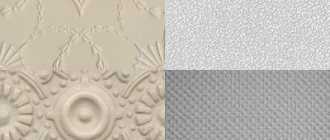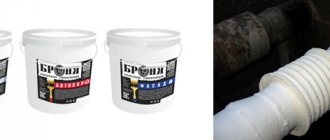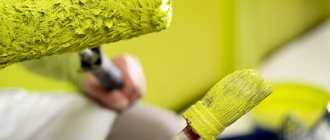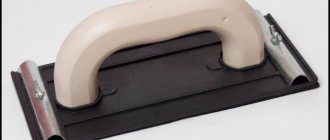Device Features
Structurally, the rollers consist of two elements - the machine and the working surface - a cylindrical coat. The machine includes a yoke and a handle. The handles are made of wood or plastic; they have a comfortable shape and fit well in the hand. There is no specific standard for making a handle; each model of wall paint roller has its own handle. When choosing a tool, it is important to consider that its weight and size are combined, the handle should lie comfortably in the hand, and the working area should not be heavier than the handle, otherwise it will be difficult to work and the hand will get tired quickly.
The rollers have different attachment attachments; the roller can be secured in three ways:
- hard. In this case, the instrument is not dismountable; when the coat wears out, the device will have to be thrown away;
- with coupling. When the working area wears out, it can be easily replaced with a new coat;
- frame system - such a tool can be used repeatedly, it does not have a core.
One or another mounting option can be chosen based on personal preferences. In addition to the fact that the rollers differ from each other in the type of handle and the method of attaching the attachment, the coats or working areas of these tools are made of different materials.
Sizes and types of paint rollers
In turn, paint rollers differ in the length of the coat, the width and diameter of the working surface.
- Small rollers up to 15 cm long and up to 3 cm in diameter are used for painting narrow or small surfaces, or hard-to-reach places.
- The average roller has a length from 15 to 25 cm and a diameter from 5 to 9 cm. Rollers of this size are considered universal; they are used for most painting jobs, as well as for leveling wallpaper when gluing.
- Large roller. Its length is over 25 cm, and its diameter is from 8 cm. Such rollers are used for facade painting. Working with such a tool requires professional skills and some experience.
Types of rollers
Thanks to the wide variety of work area materials, you can choose the most suitable paint roller for a specific type of work. There are a lot of varieties of coats, each of them is used for certain paints and varnishes; the market today offers rollers made from the following materials:
- foam;
- velours;
- fur;
- polyamide;
- polyester;
- polyacrylic;
- threads
Each of the above options has its own characteristics and cost. Fur attachments apply paint in an even layer; experts say that it is better to choose a natural fur coat. It has a long service life, does not leave bubbles on the surface, absorbs a small amount of paint, so it applies the coloring composition practically without splashes. The only drawback of fur rollers is lint loss. Villi remain on the surface of the walls and spoil the appearance. To prevent this from happening, it is better to use a high-quality nozzle.
If the walls are uneven and have many cracks that need to be filled with paint, then it is better to use a long-haired nozzle for painting the walls. And to paint smooth and even walls, you should choose a velor roller, which has almost the same characteristics as a fur tool, but it does not leave hairs behind.
Polyamide is a good material that is resistant to aggressive paints and varnishes. The fur coat lasts quite a long time, it absorbs paint well and transfers it to the wall. Polyamide rollers are easy to clean after painting the walls.
Polyacrylic is a lower quality material, similar in properties to polyamide; polyacrylic rollers paint quite well. Polyamide coats are suitable for painting with different types of paint mixtures, and polyacrylic nozzles are recommended to be used only for water-based paints.
Foam rollers are the simplest and cheapest; they can be found in any hardware store. Foam rubber is great for painting smooth, even walls, but such a roller has difficulty painting various irregularities. Foam rubber products are quite inexpensive; they are often purchased for one use, after which the nozzle is thrown away.
Rollers with long threads are suitable for quickly painting walls. You need to work with them slowly to avoid splashes. They can be classified as relief tools that leave very attractive, original patterns and designs on the walls.
Textured rollers
Textured roller attachments are a separate category of tools that are suitable for creating unusual textures on walls. Textured rollers are made from foam rubber, rubber, wood and other materials. A textured attachment is a stencil that leaves a pattern on the wall.
A figured or textured roller is usually used when the wall already has a finish, for example, plaster without relief or an even layer of paint. After the first layer of finishing has dried, the wall is decorated with a textured roller. As a result, a beautiful pattern, pattern or ornament is formed on the surface.
Types of rollers by size
Its purpose will largely depend on the dimensions of the roller. For example, when painting walls, it is better to choose a tool with a wide working part, and rollers for corners should be short. The following roller sizes are available:
- Mini rollers. The width of the working part is no more than 150 mm, and the diameter is 15 cm. They are used for working on surfaces with complex terrain.
- Midi rollers. The working surface parameters vary from 150 to 250 mm. Diameter from 50 to 90 mm. Such models are considered universal, as they are suitable for painting all kinds of surfaces.
- Facade rollers. The width of their working surface exceeds 250 mm with a diameter of 80 mm. This instrument is classified as professional. It is used for uneven surfaces of an impressive area. Working with such rollers requires special skills.
You should choose paint rollers by size based on your own experience and skills, as well as the type of surface that needs to be painted. In most cases, a midi roller is considered optimal.
Due to their large size, façade rollers are capable of absorbing an impressive amount of paint. Therefore, working with these types of products is difficult and tiring.
Which roller should you choose?
Many people are interested in what is the best roller to choose to paint the walls? The tool must be selected depending on the condition of the surface, the type of paint and varnish composition used, as well as the expected result. Some people want to create beautiful patterns on the wall, a textured roller is suitable for this, and some want to simply paint the wall in one color, for this they need to choose a coat made of material that is resistant to the aggressiveness of the paint used.
It is very unusual and original to create a design using a stencil roller, on the coat of which some design appears. Rollers with stencils make it easy to join together designs that were applied earlier, so the feeling of a complete picture or pattern is visually created. Some people prefer to choose a patterned paint roller, this type of tool is used for rolling over wet, plastic putty. Thanks to this, a textured surface with a pattern is obtained.
To use a certain type of paint, you need to select the appropriate coat. Foam rubber attachments are the cheapest; they are usually used once and become unusable after painting. But if you plan to use a paint roller many times, then you need to purchase a more expensive tool; it must be suitable for a certain type of paint composition:
- For painting with water-based paint. If it will be applied to a flat surface, it is better to choose one of the following rollers:
- thread;
- foam;
- nappy.
Most often, thread rollers are used to paint walls. Foam rubber absorbs a large amount of paint, this negatively affects the quality of painting. Thread coats absorb much less paint and varnish composition, so the mixture is applied in an even layer. The length of the piles must be chosen as follows: for smooth walls use a short pile, and for uneven surfaces it is better to choose a long-pile roller.
- For applying acrylic paints. Acrylic paints have a special texture, so they are often used in modern decoration, but they require the right tools to apply them. The most suitable roller for acrylic paint is a velor tool. In addition to this, a foam tool is also suitable, but only if it is of good quality.
To perform exterior, facade painting work, it is better to choose a polyacrylic roller. A polyester coat is also suitable for outdoor painting, but only if the length of the lint is less than 6 millimeters, and for painting uneven, rough walls it is better to use a lint roller 15-20 millimeters long.
Attention! It is highly not recommended to use rollers with a foam base, because the paint will quickly corrode the foam.
Experts recommend adhering to the following recommendations when choosing a roller in a store:
- The roller coat must match the chosen type of paint. It is important to make sure that the material from which the nozzle is made is suitable and will not deteriorate after the first painting;
- it is necessary to decide how much work will be performed, based on this, you need to select the width of the roller and its diameter;
- If you need to apply any decorative pattern to the wall, then you need to choose it from the wide variety of options offered.
How to buy the perfect tool?
It is not always possible for novice craftsmen to paint ceiling surfaces and walls with water-based paint with maximum comfort. A person wisely chooses the type of coloring composition and roller material. But the work is still going slowly, the decor is of poor quality. The reason in such cases is the incorrect selection of painting tools.
When choosing a roller, pay attention to the following:
- Appearance of the instrument. There should be no cracks or knots on its handle that would interfere with operation. The fibers should be even and adhere tightly to the pillow. It is easy to check the quality of the offered product. Squeeze (lightly) the villi with your fingers. We easily pull them towards ourselves. If the pile falls out of the pad, choose another roller.
- The smoothness of the seams on the fur coat. We choose rollers with uniform pads. We do not buy instruments with rough seams. Such devices for painting work are guaranteed to leave marks on the treated base, and we will have to repaint the same area several times.
- Roller functionality. If you plan a large amount of complex work, it makes sense to purchase a tool equipped with regulators, a telescopic handle and special limiters. The presence of such additional elements significantly simplifies and speeds up the process of painting surfaces with water-based paints. True, the cost of sophisticated tools is usually high.
Now you know exactly how to choose a roller correctly. The right tool will make the process of applying water-based paint a simple and even enjoyable experience. Good luck!
How to use a roller
To paint walls accurately and perfectly evenly, you need to know how to work with a roller correctly. Coloring has some features:
- Using masking tape, you need to mark the boundaries of the painting in advance. The adhesive tape must be placed on the same level; this level is checked with a laser or other level. The masking tape must be pressed tightly against the wall so that paint does not get under it. The location of the tape can be horizontal or vertical; the height and shape depend on the interior design and the preferences of the owner. When the paint is completely dry, the masking tape comes off;
- You cannot completely immerse the entire roller in the paint; the axis of this tool must be dry. It is best to pour the paint into a special tray with a ribbed surface. First, the roller is dipped in the paint and varnish composition, after which it is rolled over the ribbed surface, and the paint is applied to the wall;
- It is best to paint with movements similar to the letter W. You can paint the first layer in a horizontal direction, and the second layer in a vertical direction;
- all hard-to-reach areas are painted with a brush;
- It is advisable to start painting from the doorway or from the corner; it is better to do this with a small roller;
- You should not apply a lot of paint at one time, as drops and streaks will appear. If the paint begins to flow on the wall, it must be rolled out;
- when the first layer is completely dry, you can begin applying the second coating;
- During painting, all furniture and objects in the room must be protected with cellophane film. Window and door frames also need to be protected. It is much easier to protect them with masking tape or film than to wipe the paint off of them;
- if painting will be carried out near electrical wiring, then the power supply must be turned off, all sockets must be protected with tape;
- if paint gets on any surfaces or objects, for example on the floor or furniture, it must be removed immediately with a dry cloth;
- It is important to paint using personal protective equipment - goggles, a respirator, gloves and thick clothing.
Features of choosing a roller for acrylic paint
On the question of which roller to paint the ceiling when using acrylic paint, the opinions of different masters often differ. Some specialists always have several removable roller attachments in stock and select the appropriate model in a practical way. If you look at some training manuals, they recommend using a drum with a coat of short pile or foam rubber for acrylic paint. Moreover, in the second case, it is recommended to attach a special attachment to the handle to hold the flowing paint.
The disadvantages of foam rubber have already been discussed, but let’s still look at the variety of this material. A high-quality foam roller can be distinguished by its blue color. It may work for acrylic paint, but it will still run down the handle. But the yellow foam rubber on the drum has a highly porous structure with large cells. After applying the paint layer with such a drum along the plane, many bubbles will remain on the acrylic.
Soft pile with a length of 6 to 18 mm is best suited for acrylic paint. Short pile will pick up little liquid. But a sheepskin coat is best suited for acrylic painting of a surface. We can say that you can paint the ceiling with acrylic paint using a roller covered with any material, but you should give preference to a tool whose pile does not tend to cake. Ideally, you should paint the ceiling with acrylic paint only with a finishing layer. This work is done with a roller with a velor coat.
DIY roller
It is not necessary to purchase a roller in a store; you can make it yourself. It is very easy to create a decorative fur coat at home from scrap materials. The roller can be made from an old rolling pin or from a plastic pipe, at the end of which plugs are placed. The axis and handle of this tool can be made of thick wire. A fur coat can be made, for example, from:
- plastic bag,
- rubber,
- nets for vegetables,
- pieces of fabric
- skin,
- pieces of foam rubber,
- foil,
- rope or rope,
- foam sponge,
- any other available materials.
You can even use regular newspaper to create a unique design on the wall. By winding these materials onto the surface of the roller and applying paint with this tool to the wall, you can create unique patterns, ornaments and designs that will become a real decoration of the room.
Painting technology
Having figured out how to choose a roller for painting the ceiling, we begin the process itself. Painting with a roller begins with stripping the surface of the old finish, repairing cracks and puttying the entire surface to a perfectly smooth state. The putty surface is rubbed with sandpaper or a special mesh, giving it a mirror finish. The final preparatory work is priming the prepared surface.
Painting begins with hard-to-reach places. These will definitely be corners, borders, and in multi-level structures - various protruding elements. The best way to do this is to use a brush. Complex structures are painted over with a 50 mm overhang onto a flat plane. Further work is carried out with a roller, applying one or several layers of paint until the desired result is achieved. Before applying a new paint layer, the previous one must dry.
Preparing the room for painting
Painting walls with a roller, tricks when distributing a water-based product begin with the preparatory stage. It is imperative to remove the old finishing material. Applying the product over whitewash or oil-based compounds is not allowed.
Removing old whitewash and paint
Removing a thick layer of whitewash requires first making notches along the base, then soaking the wall or ceiling with water, leaving the surface to soak for 30 minutes. After this time has passed, the base is wetted again to wait for good wetting. Soaked whitewash can be removed with a spatula. Finally, you will need to wipe the surface with a sponge.
If the whitewash is not thick, then creating notches is not required.
If the previous coating is a water-based composition, then the procedure is similar. But with an oil composition it will be more difficult; usually the surface is heated with a hair dryer, and the softened coating is removed with a spatula.
If the hairdryer fails, you will need to use chemical removers. It is important to create good ventilation, the windows also open, the master must wear gloves, a respirator and protective clothing. The surface is impregnated with a sponge soaked in the substance. Wait the time specified in the instructions and wash the layer. The procedure may need to be repeated several times.
You can also use a mechanical cleaning method using grinding. It is more convenient to work with an electric tool.
Soaked whitewash can be removed with a spatula.
Puttying and priming
This stage is necessary if there are uneven areas; such problems usually exist on the surface. First, the base is tapped with a hammer to identify poorly adhering layers and clean them.
If large flaws are found, you will need to fill them with a sand-cement composition, then the entire base is treated with a starting-type putty composition, followed by a primer and finishing putty.
The stage ends with sanding the surface; you can use sandpaper or a sander.
The primer solution is distributed over the base with a roller. A two-layer coating is made, each one must dry completely before the next.
The primer solution is distributed over the base with a roller.
Made from velor
It is advisable to choose such a roller for painting a flat, smooth surface. Velor synthetic material and products made from it are much cheaper than, for example, mohair rollers. Another undoubted advantage of velor rollers is their resistance to aggressive solvents.
However, the inconvenience in using this type of product is that velor does not absorb water-based paint well. In order to achieve an even, uniform coating, you will have to dip the tool into the coloring solution too often, which creates a lot of inconvenience for the painter.











